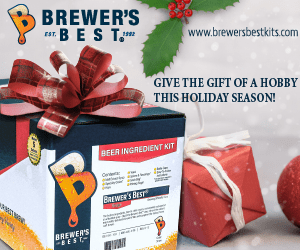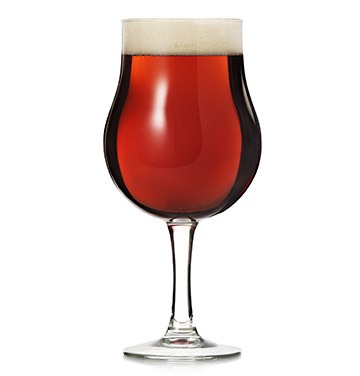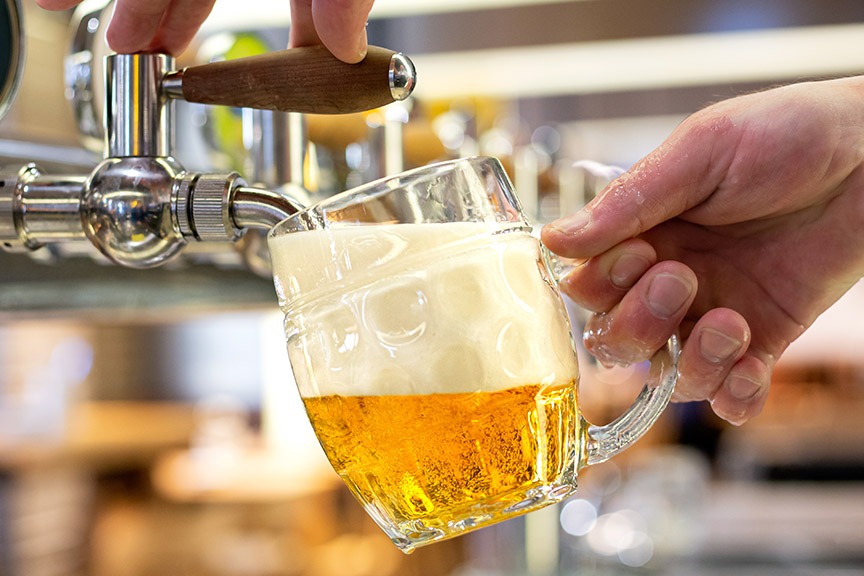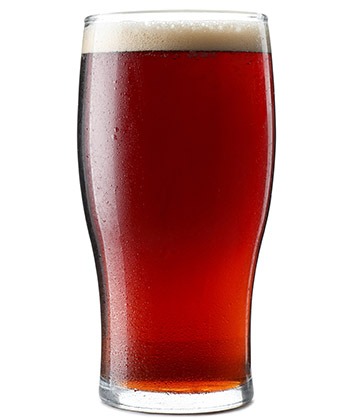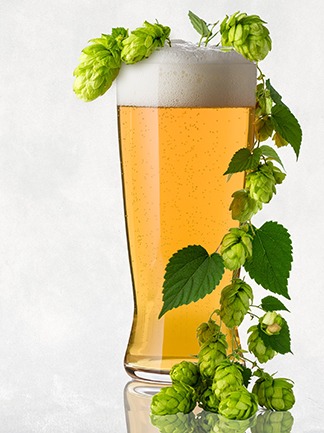American Brown Ale
By the numbers
- OG: 1.045–1.060 (11.2–14.7 °P)
- FG: 1.010–1.016 (2.6–4.1 °P)
- SRM: 18–35
- IBU: 20–40
- ABV: 4.3–6.2%
It is said that the first American brown ale was a creation of homebrewers in and around Texas. It possibly started as an attempt to brew an “Americanized” version of an English brown ale, but it quickly became much more than that — more of a style of its own.
American brown ale is not just bigger, hoppier and roastier than an English brown ale. The choices for hopping, malt and fermentation create a beer with a different overall character from the English brown ales. It may seem obvious to some, but an American brown should always be brown. It can range from light to very dark brown, but it shouldn’t be black and it shouldn’t be amber, which are the odd mistakes you sometimes see in recipes. The overall balance can seem a little on the sweet side up front, but it should never finish sweet. It can have a medium to fairly dry finish and a medium to medium-full body. Fruity esters are generally no more than a gentle presence and in many examples very low or none at all.
All good examples should have some level of chocolate, toasty caramel flavors and aromas. While there should be some chocolate malt character and maybe even a tiny touch of coffee, it is important to note that this should stop short of being too much like a robust porter. How bold those flavors are in each beer and the amount of residual malt sweetness as compared to the hopping, makes up the wide range of interpretations of this style.
American brown ales vary from being very hoppy, very bitter beers to beers with a more restrained hop bitterness and character. Some examples have a little sweetness up front and a rich background malt flavor that balance the hops, while others are drier, letting the hops come straight through and poke you in the tastebuds. Being an American style, you’d think that a citrusy character is a requirement, but not necessarily. Almost any hop character is fine, from restrained to bold, but the bittering should always be firm.
You have some flexibility in choosing base malt for American brown. Using domestic two-row will give the beer a clean, subtle background malt character common to many fine American craft beers. Using domestic pale ale malt adds a slightly richer background malt character, somewhat of a light bready note. Again, this is the type of malt character you’ll find in many fine domestic craft brews. Less common is the use of British pale ale malt. British pale ale malt provides an even greater depth of malt character to the beer, mainly a biscuit-like taste and aroma common in many British beers. Some folks feel British pale ale malt can be too much for American styles, so if you prefer a more subtle, restrained malt background, go with domestic two-row or pale ale malt. Extract brewers can use an English pale ale extract if they want a richer malt background or a light color North American malt extract if they want a more subtle taste. All-grain brewers can use a single infusion mash and should target a mash that will leave enough long chain sugars in the beer to help fill out the body. A temperature around 152 to 154 °F (67 to 68 °C) creates wort with a nice balance between fermentable and non-fermentable sugars.
The majority of the character that defines an American brown comes from specialty malts and this is one area ripe for creativity. Every American brown needs both some chocolately dark malt notes and some caramel notes. Experimenting with the amounts and colors of crystal and roasted malts is a great way to change the character of your beer. I like to use mid-color crystal (40–60 °L), darker crystal (80–150 °L) or a combination of colors. The mid-color crystal malts add more caramel flavors, while the darker crystal malts add progressively more plum, raisin and burnt caramel notes as they get darker. The darker crystal malts also tend to be less sweet than the lighter crystal malts. Even though you have a lot of leeway, you don’t want to add a lot of low color crystal malt (< 30 °L), as it adds sweetness without much caramel character. Also watch the total amount of crystal malt being added. If the total amount exceeds 10% of the grist, it can result in an overly sweet and heavy beer.
It is important to not leave too much residual sweetness in the beer. Even with a high level of bitterness, there is a limit to how much sweetness is acceptable. While there is some truth to the adage that you can balance hop bitterness with malt sweetness, that is true only to a point and it doesn’t take much before the drinkability of the beer suffers. One of the other benefits of the darkest crystal malts is that they add a little dryness to the finish. Any dark roasted malt can enhance the perception of dryness, but each malt or grain has its own character. Some can be
harsh and acrid if used in more than the smallest amount. Generally speaking, the darker the malt the less you’ll need to use in an American brown. Keep in mind that you only want some restrained flavors and aromas, since you’re not trying to make a robust porter or a stout of any kind. About 5% is the limit on the amount of the darker roasted malts and that should be in the 300 to 500 °L range. Use much, much less, however, if you’re going darker.
If you’re looking for more complexity or head retention or some other flavor in your brown it is possible to add other malts as well. CaraPils®, wheat malt, Victory® and Munich are common additions to many American brown recipes. Just use restraint so the beer doesn’t become saturated with unfermentable dextrins or cloying flavors. Target between 0 and 5% for these additional specialty grains.
You have quite a bit of flexibility in hopping American brown ales. The balance of bittering versus malt sweetness can range anywhere from slightly sweet to boldly bitter. Target a bitterness to starting gravity ratio (IBU divided by OG) of 0.5 to 0.7 for a more balanced beer or 0.7 to 1.0 for a bold American brown. The BJCP guide suggests that IPA strength examples are really specialty beers, so you might want to stop short of turning your beer into a brown IPA. However, here on the West Coast IPA-strength beers in alcohol and hops is a common occurrence and nobody blinks an eye at a bold brown ale.
Hop flavor and aroma also varies from minimal to bold. I really like using citrusy or piney American variety hops such as Cascade, Centennial, Columbus, Simcoe and Amarillo® for flavor and aroma, but there are plenty of great examples out there that use a wide variety of hops from around the world. You can use almost any hop you feel has a pleasant character as it is the overall impression that matters. Fermentation for American brown is straightforward. Like the majority of American ales, this style most often has a clean profile, with very low to no fruity esters. A slight fruitiness can be welcome, as long as it isn’t excessive. If you do want some esters, an English-style yeast at a lower temperature is a common technique. But keep in mind those yeasts often attenuate a little lower than most American-style yeasts, so you’ll need to account for that in your recipe formulation. I prefer to use a clean, moderately attenuating yeast, such as Wyeast 1056 American Ale or White Labs WLP001 California Ale. Make certain that you oxygenate the wort and pitch an appropriate amount of clean, healthy yeast for the batch you are brewing. This will help create that clean American pub-style profile in the beer. Ferment at around 67 °F (19 °C), holding the temperature steady throughout fermentation. Holding the temperature steady is important to getting a proper level of attenuation and avoiding off-flavors.
Dirty Water Brown
(5 gallons/19 L, all-grain)
- OG = 1.048
- FG = 1.011
- IBU = 34
- SRM = 21
- ABV = 4.9%
This recipe makes an American brown on the lower side of the style; hoppy, but lower in alcohol and bittering, for those times when you want to have a couple of pints.
Ingredients
- 9 lbs. (4.1 kg) Great Western pale malt (2-row) (2 °L) or similar
- 7 oz. (200 g) Great Western crystal malt (40 °L) or similar substitute
- 7 oz. (200 g) Great Western chocolate malt (420 °L) or similar
- 4 oz. (113 g) Great Western crystal malt (60 °L) or similar
- 4 oz. (113 g) Briess Victory® malt (28 °L)
- 4.94 AAU Horizon hops (0.38 oz./ 11 g at 13% alpha acid) (60 min.)
- 7.47 AAU Amarillo hops (0.83 oz./24 g at 9% alpha acid) (15 min.)
- 13.14 AAU Amarillo hops (1.46 oz./41 g at 9% alpha acid) (0 min.)
- Wyeast 1056 American Ale, White Labs WLP001 California Ale or Fermentis Safale US-05 yeast
Step by Step
Mill the grains and dough-in targeting a mash of around 1.5 quarts of water to 1 pound of grain (a liquor-to-grist ratio of about 3:1 by weight) and a temperature of 152 °F (67 °C). Hold at 152 °F (67 °C) until enzymatic conversion is complete. Infuse the mash with near boiling water while stirring or with a recirculating mash system raise the temperature to mash out at 168 °F (76 °C). Sparge slowly with 170 °F (77 °C) water, collecting wort until the pre-boil kettle volume is around 6.5 gallons (25 L) and the gravity is 1.037 (9.3 °P).
The total wort boil time is 90 minutes. Add the bittering hops with 60 minutes remaining in the boil. Add Irish moss or other kettle finings and second hop addition with 15 minutes left in the boil. Add the last hop addition at flame out. Chill the wort to 67 °F (19 °C) and aerate thoroughly. The proper pitch rate is 9 grams of properly rehydrated dry yeast, two packages of liquid yeast or one package of liquid yeast in a 1.5-liter starter.
Ferment at 67 °F (19 °C) until the yeast drops clear. At this temperature and with healthy yeast, fermentation should be complete in about one week. Allow the lees to settle and the brew to mature without pressure for another two days after fermentation appears finished. Rack to a keg and force carbonate or rack to a bottling bucket, add priming sugar, and bottle. Target a carbonation level of 2 to 2.5 volumes.
Extract with grains option
Replace the North American pale malt with 5.7 lbs. (2.6 kg) light liquid malt extract. For this recipe, I use an ultra-light extract made from Great Western two-row malt by Alexander’s (California Concentrate Company), but any fresh, high quality light color extract made from domestic two-row malt will work well. If you can’t get fresh liquid malt extract, use dried malt extract (DME). (Use 20% less dry extract by weight.) When the amount of liquid extract called for in the recipe is not easy to measure, use the most convenient liquid measure and you can make up the rest of the malt sugars with dry extract. Always choose the freshest extract that fits the beer style.
Mill or coarsely crack the specialty malts. Mix them well and place loosely in a grain bag. Avoid packing the grains too tightly in the bag, using more bags if needed. Steep the bag in about 1 gallon (~4 L) of water at roughly 170 °F (77 °C) for about 30 minutes. Lift the grain bag out of the steeping liquid and rinse with warm water. Allow the bags to drip into the kettle for a few minutes while you add the malt extract. Do not squeeze the bags.
Add enough water to the steeping liquor and malt extract to make a pre-boil volume of 5.9 gallons (22.3 L) and a gravity of 1.041(10.2 °P). Stir thoroughly to help dissolve the extract and bring to a boil. Boil time is 60 minutes. Get the wort boiling, add your first addition of hops, then follow the boil, fermentation and packaging instructions for the all-grain version.
Janet’s Brown Ale
(5 gallons/19 L, all-grain)
- OG = 1.066 (16.2 °P)
- FG = 1.016 (4.2 °P)
- IBU = 63
- SRM = 23
- ABV = 6.6%
Ingredients
- 10.75 lbs. (4.87 kg) Great Western North American two-row malt (2 °L) or similar substitute
- 18 oz. (510 g) Great Western Crystal malt (40 °L)
- 18 oz. (510 g) Briess CaraPils®malt (1 °L)
- 14 oz. (397 g) Great Western Wheat malt (2 °L)
- 8 oz. (227 g) Chocolate malt (420 °L)
- 5.4 AAU Northern Brewer hops (0.83 oz./24 g at 6.5% alpha acid) (mash hop)
- 6.76 AAU Northern Brewer hops (1.04 oz./29 g at 6.5% alpha acid) (60 min.)
- 5.4 AAU Northern Brewer hops (0.83 oz./24 g at 6.5% alpha acid) (15 min.)
- 7.5 AAU Cascade hops (1.25 oz./35 g at 6% alpha acid) (10 min.)
- 7.5 AAU Cascade hops (1.25 oz./35 g at 6% alpha acid) (0 min.)
- 15 AAU Centennial hops (1.67 oz./47 g at 9% alpha acid) (dry hop)
- Wyeast 1056 (American Ale), White Labs WLP001 (California Ale) or Fermentis Safale US-05 yeast
Step by Step
Mill the grains and dough-in targeting a mash of around 1.5 quarts of water to 1 pound of grain (a liquor-to-grist ratio of about 3:1 by weight) and a temperature of 154 °F (68 °C). Mix the first hop addition with the mash. Hold the mash at 154 °F (68 °C) until enzymatic conversion is complete. Infuse the mash with near boiling water while stirring or with a recirculating mash system raise the temperature to mash out at 168 °F (76 °C). Sparge slowly with 170 °F (77 °C) water, collecting wort until the pre-boil kettle volume is around 6.5 gallons (25 L) and the gravity is 1.051 (12.7 °P).
The total wort boil time is 90 minutes. Add the bittering hops with 60 minutes remaining in the boil. Add Irish moss or other kettle finings along with the third hop addition with 15 minutes left in the boil. Add other hop additions at 10 minutes remaining and flame out. Chill the wort to 67 °F (19 °C) and aerate thoroughly. The proper pitch rate is 11 grams of properly rehydrated dry yeast, two packages of liquid yeast or 1 package of liquid yeast in a 2.5-liter starter.
Ferment at 67 °F (19 °C) until the yeast drops clear. At this temperature and with healthy yeast, fermentation should be complete in about one week. Allow the lees to settle and the brew to mature without pressure for another two days after fermentation appears finished. At this point add your dry hop addition. Keep the beer on the dry hops for approximately seven days. Rack to a keg and force carbonate or rack to a bottling bucket, add priming sugar, and bottle. Target a carbonation level of 2 to 2.5 volumes.

